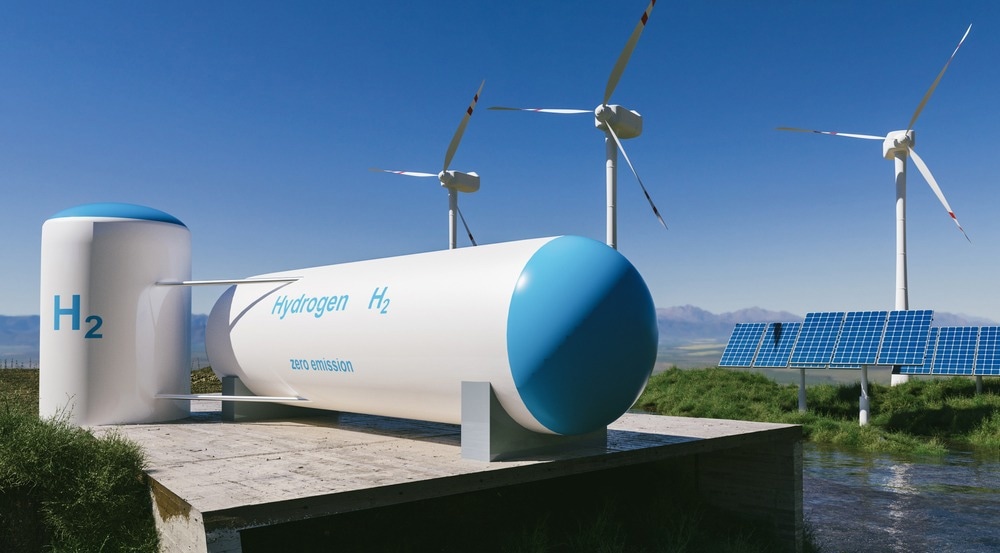Green hydrogen, also known as renewable hydrogen, will play a vital role in reducing global carbon emissions and help heavy industries move closer to a carbon-neutral future. Global warming is one of the greatest challenges that the world currently faces.

Image Credit: Alexander Kirch/Shutterstock.com
If significant action is not taken to reduce carbon emissions, then we will not be able to prevent climate change and its profound impact on our planet. Perhaps our biggest opportunity to reduce the world’s carbon footprint is to switch from fossil fuel sources to renewable energy sources. Green hydrogen is a form of clean energy that will likely facilitate this energy transition to enable the world to move away from heavily polluting non-renewables.
A Global Commitment to Green Hydrogen
President Biden has made a commitment to developing the use of green hydrogen in the US. With the aim of eventually reaching a hydrogen economy, an energy system where power plants run on clean-burning fuel, the US president has promised that $8 billion in federal funds will be funneled into hydrogen energy hubs. It has also been announced that $100 million will be invested by the US Department of Energy into the research and development of hydrogen and fuel cells. Other countries have made similar commitments, with the EU planning to invest $430 billion in green hydrogen by 2030, and countries including Chile, Japan, Germany, Saudi Arabia, and Australia also announcing significant investments into this field of clean energy.
Uses of Green Hydrogen
For green hydrogen to reach its full potential, it needs to be adapted for use in majorly polluting industries. Even though the green hydrogen industry is still in its infancy, five major applications of this renewable energy source have already been developed.
Hydrogen feedstocks
Green hydrogen is being used to replace existing hydrogen feedstocks. While burning hydrogen only emits water, the process of producing hydrogen can be very carbon-intensive. Hydrogen produced via green hydrogen methods, however, is produced using renewable energy instead of fossil fuels.
The total US hydrogen feedstock in 2015 was around 10 megatons, with predictions that this will rise to 14 megatons by 2030.
Switching this feedstock with green hydrogen presents an opportunity to significantly reduce the carbon emissions relating to the production of conventional hydrogen.
Residential and commercial heating systems
Green hydrogen is also being used to decarbonize residential and commercial heating systems, which are a major source of carbon emissions in many countries. Green hydrogen is mixed with natural gas as a ‘quick fix’ to reduce heating-related emissions. However, this is only feasible where natural gas prices are relatively high.
Energy storage
Energy storage is another key application of green hydrogen. A major application of traditional hydrogen energy is to produce fuel cells.
Scientists are currently working on developing batteries from energy produced from renewable energy via electrolysis, however, initial attempts have resulted in a drop in energy efficiency compared with conventional batteries.
While this significant challenge must be overcome before green hydrogen can be used in energy storage, recent studies have shown that green hydrogen for energy storage applications is cost-effective when energy storage is required for more than 13 hours.
Alternative fuel production
The fourth major application of green hydrogen is in the production of alternative fuels.
Currently, scaling-up green hydrogen production for a range of applications faces a number of challenges relating to distribution and storage. One route to tackling these challenges is to convert hydrogen into a less volatile and less flammable compound such as ammonia or methane. However, as energy is lost in this conversion, this approach is only appropriate when the resultant product has a relatively high value.
Fuel cell vehicles
Green hydrogen is being used to power fuel-cell vehicles. This application of green hydrogen is one of the most often cited uses of the renewable energy source, however, green hydrogen fuel-cell vehicles have yet to gain significant traction in the automotive market.
In the next decade, it is likely that green hydrogen will be important for other applications rather than replacing internal combustion engines in vehicles. However, fuel cell vehicles may gain traction in certain markets, such as industry and manufacturing that rely on forklift trucks and other material-handling vehicles.
Future Directions of Green Hydrogen
Green hydrogen is emerging as a vital component to encourage energy transition from fossil fuels to renewables to secure a sustainable future for the planet.
As the cost of green hydrogen production decreases and the technology to develop it becomes more advanced, we will likely see more applications of green hydrogen.
Blue hydrogen, for example, is one key off-shoot of green hydrogen that may see rapid adoption in the coming years. Blue hydrogen is green hydrogen that has been produced by natural gas and is being increasingly used in energy storage for vehicles as well as for heating buildings.
References and Further Reading
David Baker, 2022. Biden’s Hydrogen Hub Plan Sparks $8 Billion Race Among U.S. States [online]. Bloomberg. Available at: https://www.bloomberg.com/news/articles/2022-04-08/biden-s-hydrogen-hub-plan-sparks-8-billion-race-among-u-s-states (last accessed August 2022)
Li, Y. and Taghizadeh-Hesary, F., 2022. The economic feasibility of green hydrogen and fuel cell electric vehicles for road transport in China. Energy Policy, 160, p.112703. https://www.sciencedirect.com/science/article/pii/S0301421521005681
Perez, R., Brent, A. and Hinkley, J., 2021. Assessment of the Potential for Green Hydrogen Fuelling of Very Heavy Vehicles in New Zealand. Energies, 14(9), p.2636. https://www.mdpi.com/1996-1073/14/9/2636
Orsted. [Online]. Renewable hydrogen. Available at: https://orsted.co.uk/energy-solutions/renewable-hydrogen?gclid=Cj0KCQjw9ZGYBhCEARIsAEUXITUN4EGG5XRFGcq_R11x1oIRKZqS3em_k0-xyAqGtu0_D-XSBEgkpM4aAuEvEALw_wcB (last accessed August 2022)
Disclaimer: The views expressed here are those of the author expressed in their private capacity and do not necessarily represent the views of AZoM.com Limited T/A AZoNetwork the owner and operator of this website. This disclaimer forms part of the Terms and conditions of use of this website.